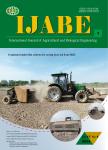Water use efficiency and yield responses of cotton to field capacity-based deficit irrigation in an extremely arid area of China
作者机构:State Key Laboratory of Desert and Oasis EcologyXinjiang Institute of Ecology and GeographyChinese Academy of SciencesUrumqi 830011China School of Environmental and Land Resource ManagementJiangxi Agricultural UniversityNanchang 330045China Cele National Station of Observation&Research for Desert-Grassland Ecosystem in XinjiangCele 848300XinjiangChina University of Chinese Academy of SciencesBeijing 100049China
出 版 物:《International Journal of Agricultural and Biological Engineering》 (国际农业与生物工程学报(英文))
年 卷 期:2019年第12卷第6期
页 面:91-101页
核心收录:
基 金:The authors wish to acknowledge the funding from Xinjiang Thousand Youth Talents Plan Project(Y672071001) the Doctoral Foundation of Jiangxi Agricultural University(9232304717) the China Scholarship Council program(CSC,201608360137) the National Natural Science Foundation of China(NSFC,U1603343)
主 题:regulated deficit irrigation evapotranspiration seed cotton yield water use efficiency Qira Oasis
摘 要:The objectives of present investigation were to test the effects on water use efficiency(WUE)and cotton yield of implementing a range of deficit irrigation regimes triggered at specific fractions of root zone soil moisture,field capacity(θfc)and different crop phenological *** study was conducted on southern oasis of the Taklamakan desert,*** cotton crop’s WUE was quantified,as were leaf photosynthesis and *** a photosynthetic perspective,deficit irrigation resulted in 16.8%,10.3%and 2.2%increases in leaf WUE underθfc-based regulated deficit irrigation(T1,T2,and T3),compared to the control,*** yield and its components were significantly affected by irrigation depths(p≤0.05).A relatively high seed yield(0.65 kg/m3)and the highest WUE were achieved,under T3(70%θfc at seedling stage,60%θfc at squaring,50%θfc at full-bloom,70%θfc at boll,70%θfc at boll cracking stage),showing it to be the most effective and productive irrigation schedule *** the application ofθfc-based deficit irrigation in surface-irrigated cotton fields showed great potential in saving water,maintaining a high WUE,and improving cotton seed yield,a management strategy consisting or irrigation thresholds of 70%θfc in the root zone at the seedling,boll and boll cracking stages,and of 60%θfc at the squaring stage,and 50%θfc at the full-bloom stage,would be recommended for this extremely arid region.



